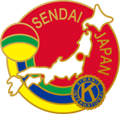

An international volunteer organization serving the children of the world
Kiwanis Club of Sendai, Inc.
About Kiwanis
About Kiwanis
The word “kiwanis” originates from “Nun-Kee-Wanis” meaning “getting together”
used by a native American tribe around the Detroit Area in the early twentieth century.
Kiwanis International is composed of about 8,000 Kiwanis Clubs spread around the world with about 200,000 individuals
belonging to the Kiwanis Clubs as members. It is one of the three major international volunteer service organizations.
2015 is the centennial year of Kiwanis International. Since 1990, it puts special emphasis on service for children.
Together with the Kiwanis-Family organizations such as Circle K and Key Clubs for youth, about 600,000 members
are involved in Kiwanis activities. The headquarters of Kiwanis International is located in Indianapolis, Indiana, U. S. A.
At the occasion of the 90th Anniversary, Kiwanis decided “Serving the Children of the World”
as its motto to clarify its main objective of service for children.
The Objects of Kiwanis International (Adopted at the 1924 International Convention in Denver, Colorado, U. S. A.)
- To give primacy to the human and spiritual, rather than to the material values of life.
- To encourage the daily living of the Golden Rule in all human relationships.
- To promote the adoption and the application of higher social, business, and professional standards.
- To develop, by precept and example, a more intelligent, aggressive, and serviceable citizenship.
- To provide, through Kiwanis clubs, a practical means to form enduring friendships, to render altruistic service, and to build better communities.
- To cooperate in creating and maintaining that sound public opinion and high idealism which make possible the increase of righteousness, justice, patriotism, and goodwill.
Kiwanis Global Campaigns for Children
Sustained eradication of Iodine Deficiency Disorders (IDD)
To eradicate IDD that is a major but preventable cause for mental retardation, worldwide members of Kiwanis-Family joined force
in 1994 with UNICEF, and succeeded in completing in 2005 the campaign by raising over 100 million US dollars. Kiwanis is noted for the success.
To sustain the eradication, Kiwanis continues to play major roles for in enlightenment and monitoring.
Monthly intake of a few hundred micrograms of Iodine is essential for thyroid hormone, its shortage causing dementia and preventing growth.
IDD is nonexistent in Japan thanks to regular diet of sea weed.
In the 1920’s, developed countries started adding iodine to dietary salt. We needed to install iodine adding equipment
at salt factories in developing countries, and keep enlightening people and monitoring factories.
Japan provides 40% of iodine to the world. During the campaign, the Japan District of Kiwanis International succeeded in raising
1.2 million US dollars (US$ 850 per member at that time, four times the world average).
Eliminate Maternal and Neonatal Tetanus (MNT)
By the Kiwanis Centennial 2015, we are to save 129 million mothers and their future babies from MNT. Kiwanis-Family launched in July 2011
this project again jointly with UNICEF. We are to vaccinate mothers and babies in remote areas lacking adequate health services.
MNT can be easily prevented by vaccinating women of childbearing age three times. It costs only US$ 1.80 per woman.
We are to raise fund for estimated 387 million shots of vaccine.
History of Kiwanis
The first Kiwanis Club was established in Detroit, MI, U.S.A. on January 21, 1915. In early years, Kiwanis grew only in the
United States and Canada. In 1963, Kiwanis Clubs were established in three cities in Europe.
In Japan, the Kiwanis Club of Tokyo was established on January 24, 1964 as the first Kiwanis Club in the Asia-Pacific Region.
Since then, Kiwanis Clubs of Nagoya, Osaka, Hiroshima, Kobe, Sendai, Sapporo, Yokohama, Takamatsu, Fukuoka, Kyoto, Chiba, Wakayama,
Niigata, Senshu, Saitama, Nishinomiya, Shibuya, Fukuyama, Kumamoto, Shizuoka, Kanazawa, Matsue, Kagoshima, Ashiya, Fukushima, Oita,
Chiyoda have been established. As of 2011, Japan has twenty-eight clubs with over 1,600 members.
The Kiwanis Clubs in the world currently belong to about fifty “Districts” and “Kiwanis Nations”.
Among them, the Japan District was established on October 1, 1977. Under the Japan District Bylaws amended at the 2004 District Convention,
the Japan District now consists of eight “Divisions”
(Tokyo, Chubu, Kansai South, Chugoku-Shikoku, Kansai North, Hokkaido-Tohoku, Kanto, Kyushu),
each of which has a Lieutenant Governor. Each Kiwanis Club in the Japan District belongs to one of the Divisions.
Service Activities of the Japan District
- Kiwanis dolls made and donated.
- The annual Japan Kiwanis Culture Award to excellent artisans who conserved and developed traditional handicrafts.
- Nomination, to the Kiwanis International Foundation, of candidates for the Robert P Connelly Medal for Heroism and the District recognition “for service beyond the call of duty.”
- District-wide fund-raising and contribution to the Kiwanis International Foundation.
- Participation in the Annual Kiwanis International Convention and the Annual Asia-Pacific Convention, as well as the organization of the Annual Japan District Convention.
- Interclub activities.
- Individual Kiwanis Clubs annually awarding Kiwanis Awards for Public Welfare Service and Recognitions of Youth for Service Activities.
- Individual Kiwanis Clubs holding club meetings, and carrying out social and service activities.